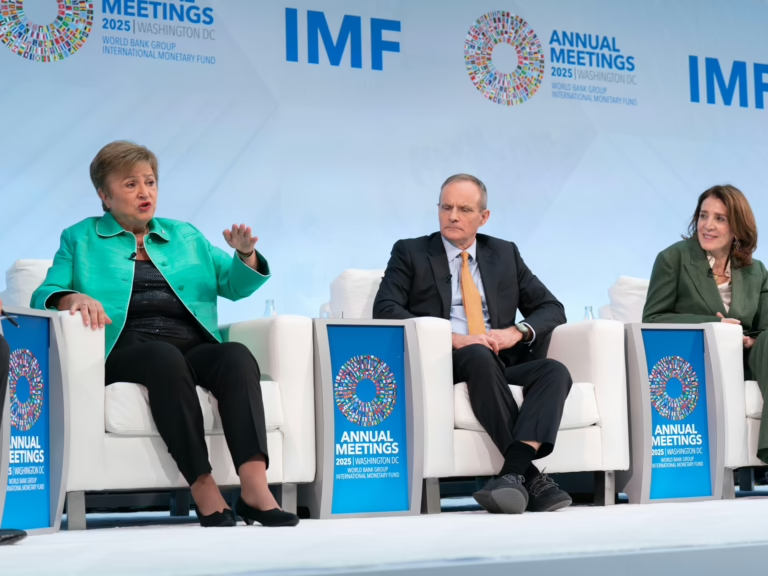This week in Washington, DC, central bankers and financial representatives convened for the annual meetings of the International Monetary Fund (IMF) and the World Bank, which will wrap up on Saturday.
The agenda has centered on the mounting global economic challenges, with the IMF highlighting emerging signs of strain linked to US trade tariffs and rising protectionist policies.
Known as a “lender of last resort,” the IMF typically intervenes when nations face severe financial turmoil and cannot secure funds through conventional means. However, its financial aid often comes with stringent conditions that may enforce austerity, potentially exacerbating social and economic difficulties, making these loans a complex remedy.
Understanding the IMF and Its Funding Mechanism
Established in 1944 at the Bretton Woods Conference in New Hampshire during World War II, the IMF was created to restore stability to the global economy after the war. Headquartered in Washington, DC, the institution has expanded from its original 44 members to 191 countries today, collaborating closely with the United Nations and other global entities to maintain financial stability worldwide.
The IMF supports countries by offering policy guidance, short-term financial aid, and capacity-building initiatives for governments and institutions.
Membership is open to any country approved by existing members, requiring payment of a quota that reflects the size of its economy. This quota determines the member’s financial contribution, borrowing limits, and voting influence within the IMF.
The Scale of the IMF’s Financial Resources
The IMF’s total lending capacity stands at approximately $1 trillion.
When extending loans, the IMF utilizes pooled funds from its member countries. Economically stronger and more stable nations act as creditors, providing the capital that the IMF lends out. These creditor countries earn interest on their contributions, with around 50 such nations collectively receiving about $5 billion in interest payments in 2024.
Countries with the Largest IMF Debt
Debt owed to the IMF is measured in Special Drawing Rights (SDRs), a unit based on a basket of five currencies: the US dollar, euro, British pound, Chinese renminbi, and Japanese yen.
Although SDRs are not a currency themselves, they can be exchanged for any of the constituent currencies. As of mid-October 2025, one SDR equaled approximately $1.36.
The IMF currently holds the highest level of outstanding credit in its history. Over the past four decades, the total amount owed to the IMF has steadily increased.
Presently, 86 countries collectively owe the IMF SDR 118.9 billion, equivalent to about $162 billion.
The top three debtors account for nearly half of this total, while the ten largest borrowers represent 73 percent of the overall debt.
Regionally, these 86 debtor countries are distributed across various continents, with Argentina leading the list, owing SDR 41.8 billion (around $57 billion), followed by Ukraine with SDR 10.4 billion ($14 billion), and Egypt with SDR 6.9 billion ($9 billion).
Why Argentina Holds the Largest IMF Debt
Argentina tops the IMF’s borrower list, with debt surpassing the combined total of the next seven largest debtors, including Ukraine, Egypt, Pakistan, Ecuador, Ivory Coast, Kenya, and Bangladesh.
In April 2025, the IMF approved its 23rd financial assistance program for Argentina, providing a $20 billion bailout aimed at stabilizing the nation’s fragile economy.
Argentina’s relationship with the IMF is characterized by frequent borrowing, making it the country with the most IMF bailouts historically. In 2018, it secured a record $57 billion loan to address fiscal imbalances amid a currency crisis and soaring inflation.
In October 2025, the US government announced a $20 billion support package for Argentina ahead of its midterm elections on October 26. This package includes a currency swap agreement, exchanging US dollars for Argentine pesos to strengthen the country’s foreign currency reserves.
Understanding Ukraine’s IMF Debt Exceeding $14 Billion
Ukraine’s economy suffered a severe downturn following Russia’s invasion in February 2022, with its external debt more than doubling since the conflict began. By April 2025, Ukraine’s government-guaranteed debt reached $152 billion, with over 70 percent ($108.4 billion) classified as external debt.
In March 2023, the IMF approved a four-year Extended Fund Facility (EFF) totaling $15.5 billion to support Ukraine’s economic stabilization, civilian expenditures, and debt servicing, especially given the country’s increased military spending.
As of October 2025, Ukraine has received $10.6 billion of the planned $15.5 billion under this arrangement for the 2023-2027 period.
Egypt’s IMF Debt and Economic Challenges
Egypt has repeatedly turned to the IMF to stabilize its economy amid high debt levels, fiscal deficits, foreign currency shortages, and inflationary pressures.
In 2016, the IMF approved an $11.9 billion Extended Fund Facility for Egypt to address persistent economic issues following the 2011 uprising, including an overvalued currency, sluggish growth, and high unemployment. The program aimed to implement a flexible exchange rate, control inflation, increase taxes, and reduce subsidies and public sector wages.
In March 2025, the IMF authorized a $1.2 billion disbursement after Egypt completed the fourth review of its $8 billion economic reform program. Inflation in Egypt nearly halved by February, aided by reforms linked to the IMF support.
IMF Debt Relative to National GDP
Although IMF loans often reach billions, they typically represent a small fraction of a country’s total debt and gross domestic product (GDP).
When measured as a percentage of GDP, the countries with the highest IMF debt ratios include Suriname (13%), the Central African Republic (9.4%), Argentina (8.3%), Barbados (7.4%), and The Gambia (6.95%).
The table below ranks countries by their IMF debt and its proportion relative to their GDP. Sorting by the “IMF credit as % of GDP” column reveals which nations carry the heaviest IMF debt burden compared to their economic size.





















